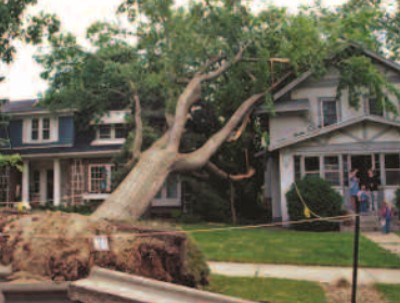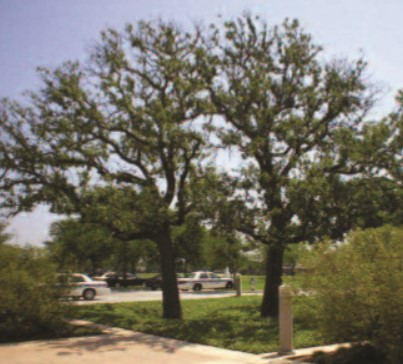The Dangers of Root Disturbance


Published March 1, 2009, By ARBORILOGICAL SERVICES
All trees are sensitive to root disturbance. Examples include construction, landscaping, sprinkler installation, and grade changes. The effects of these changes on preexisting trees can be quite devastating and can take five to ten years to become fully visible.
To understand how trees are affected by root disturbance it is important to understand the structure of a tree’s root system. Ninety percent of the root system is located in the first 12 to 18 inches of soil. The roots extend radially from the trunk one to two times the height of the tree.
During construction, the root system is cut to install foundations, sidewalks, driveways, utilities, pools, landscape beds, and irrigation systems. The closer to the tree the construction occurs, the more destructive it is.

Tree after roots are cut. Photo by Joseph O'Brien, USDA Forest Service.
THE TWO MAIN TYPES OF TREE ROOTS
1. Structural Roots
These roots anchor the tree and keep it from falling over. The structural roots begin at the base of the tree called the root flare. They grow mostly horizontally in the soil and taper in diameter as they move away from the tree. The cumulative mass of the root system keeps the tree upright, not just the tap root. The tap root can dissipate over time and is replaced with a series of sinker roots (smaller tap roots) through the entire root zone. In conclusion, the closer to the trunk roots are cut, the higher the chances the tree will be unstable and fall over. A good rule of thumb is to stay approximately six to twelve inches from the trunk for every inch in diameter the tree is at DBH (diameter at breast height or four and a half feet above grade.) For example: a 16” Live Oak requires a construction free distance of eight to sixteen feet from the trunk. Your certified arborist can assist you in deciding the critical distance depending on your individual situation.
2. Feeder Roots
These roots are the small fibrous roots that absorb water and minerals. The more of these roots that are destroyed, the more the tree’s ability to feed itself is impacted. Cutting roots is not the only way these roots are killed. Damage also occurs through compaction of the soil from heavy equipment repeatedly driving over the root zone or construction supplies being stored under and around the tree. Compaction of the soil reduces the pore space between soil particles, eliminating the oxygen in the soil which causes root death. Signs of feeder root damage are small pale colored leaves, leaves turning brown on the edges or shedding early, and the tips of the limbs dying over time.

Root damage from construction. Photo by Joseph O'Brien, USDA Forest Service.
In general, it is recommended not to remove more than 20 to 30% of the tree's live tissue, either above or below ground at a given time. Tree species react differently to construction changes, but all trees take several years to acclimate and recover.
The most common damage following construction is from irrigation installation and over-watering. Sprinkler installation can cause just as much damage as initial construction due to the amount of trenching in the root zone. When laying out sprinkler lines, limit the trenching across the root zone under the trees. Radial trenching can aid in this process.

Example of radial irrigation installation.
After all of the construction is completed and the irrigation is installed, it is critical not to over water the existing trees. Most of our native trees are adapted to dry conditions and are adapted to receiving approximately 30” of rain a year. When an increase in water occurs, the soil can stay saturated, reducing the amount of oxygen. Roots begin to rot in this anaerobic condition, and trees can decline or die. Clay soils stay saturated longer than sandier soils. It is recommended to limit watering to one inch of water a week during the growing season including rainfall. This allows the soil to be moistened and then dry out, mimicking our region’s natural rainfall pattern. Remember slope, drainage, rainfall, and sun exposure will vary the frequency and duration of the sprinkler system schedule. It is also helpful to match the water requirements of what you plant under the trees to the trees themselves. For example: planting Impatiens or Azaleas (requiring frequent waterings) under a Red Oak (preferring dryer soils) will damage the Red Oak over time.
GUIDELINES FOR TREE PROTECTION
Before Construction:
• Meet with your certified arborist
• Select trees that can be saved
• Follow your cities tree and landscape ordinances
• Consider access of construction crews and supply holding areas
• Install protective fencing around trees
• Begin getting trees as healthy as possible (fertilization and other possible treatments)
During Construction:
• Maintain protective fencing
• Maintain access paths and supply holding areas. If these areas exist over trees roots, put a thick layer of mulch (six to twelve inches deep) down to reduce compaction, remove mulch from access path after construction).
• Mulch trees in protected areas if possible (two to four inches deep)
• Water appropriately
• Apply recommended fertilization and treatment programs
• Where roots are cut, make sure the cuts are smooth and straight across (paint root cuts where and when it’s appropriate)
After Construction:
• Keep trees mulched where possible
• Water appropriately
• Continue fertilization and treatment programs
• Set up an inspection program with your certified arborist to monitor progress
Improvement of the soil through fertilization is recommended to encourage new root growth. Fertilizing three to four times a year for the first few years following root damage is common. Root regeneration can take many years, do not expect quick results.
A systemic insecticide can be added to the fertilizer application to reduce insect feeding. Borers commonly attack stressed trees causing significant and irreversible damage. Active damage can be recognized as weeping fluid or sawdust on the trunk, but it is not always visible.
Because trees are stressed during and following construction, pruning should be minimal the first few years. The more leaves and branches in the tree, the more food the tree can produce aiding in recovery. Branches causing clearance problems with houses, driveways, or streets can be pruned.
With responsible planning, implementation, and after care our trees can survive and thrive the inevitable changes our urban lifestyles create.

